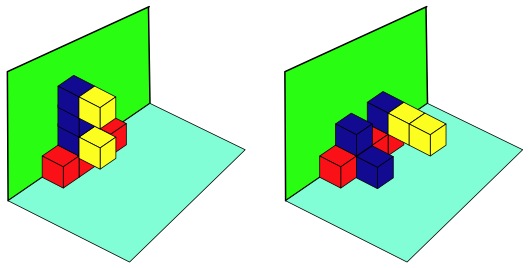Copyright © University of Cambridge. All rights reserved.
'Three Sets of Cubes, Two Surfaces' printed from https://nrich.maths.org/
Show menu
This can be used as a follow-on from Two on Five.


You have interlocking cubes of three different colours - 2 of one colour, 3 of another colour and 4 of the third colour.
It could look like this;

This is slightly different from Two on Five but is seen as an extension for some pupils. You might like to go there first!
The nine cubes are to be connected in the usual way with the following rules being applied.
The two yellow cubes are not allowed to touch the wall or floor surfaces
The Three blue cubes must touch one surface only, the wall or the floor
The four red cubes must touch both wall and floor surfaces
Here are two examples that obey the rules;

See what others you can find.
How many will there be?
At some point ask yourself "I wonder what would happen if I ...?"